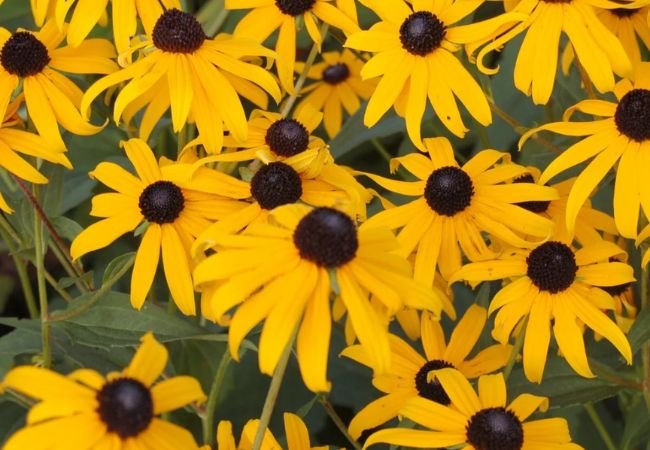Discover the captivating world of Black-Eyed Susans, a vibrant and low-maintenance flower that adds a pop of sunshine to any garden. This comprehensive guide explores the origins, cultivation, care, and numerous benefits of incorporating these cheerful blooms into your outdoor spaces, ensuring a stunning display that will brighten up your surroundings.
In the ever-changing tapestry of nature, certain flowers possess an undeniable allure that captures our hearts and imaginations. The Black-Eyed Susan, with its brilliant yellow petals surrounding a striking dark center, is one such blossom that radiates joy and warmth. Beyond its beauty, this hardy and low-maintenance flower boasts a rich history and a multitude of practical applications, making it a true gem in the gardening world. In this insightful discussion, we’ll delve into the origins, cultivation, care and numerous benefits of incorporating Black-Eyed Susans into your outdoor spaces.
Here’s a short chart with information about Black-Eyed Susans (Rudbeckia hirta):
| Aspect | Information |
|---|---|
| Botanical Name | Rudbeckia hirta |
| Plant Type | Herbaceous Perennial |
| Zones | 3-9 |
| Exposure | Full Sun to Partial Shade |
| Bloom Time | Summer to Fall |
| Height/Spread | 1-3 feet tall, 1-2 feet wide |
Origins and Botanical Background

Black-Eyed Susans, scientifically known as Rudbeckia hirta are native to North America and can be found growing wild in meadows, prairies, and along roadsides across much of the United States and Canada. These vibrant flowers belong to the Asteraceae family, which also includes sunflowers, daisies and zinnias. Their distinct appearance, with golden-yellow ray petals surrounding a dark brown or black center disk has earned them the endearing nickname “Black-Eyed Susans.”
Cultural Significance and Folklore
Throughout history, Black-Eyed Susans have held a special place in various cultures and traditions. In Native American folklore, these flowers were believed to have medicinal properties and were used to treat a variety of ailments. The Iroquois, for instance, utilized the roots and leaves to alleviate colds, fevers and other ailments. Additionally, the Black-Eyed Susan has been a beloved subject in art and literature, inspiring poets and painters alike with its vibrant hues and cheerful presence.
Cultivating Black-Eyed Susans
One of the most appealing aspects of Black-Eyed Susans is their ease of cultivation and adaptability. These resilient flowers thrive in a wide range of soil types from sandy to clay-based soils, as long as they receive ample sunlight. They are drought-tolerant and can withstand periods of dry weather, making them an excellent choice for low-maintenance gardens or naturalized areas.
Propagation can be achieved through seed sowing or by dividing established plants in early spring or fall. Black-Eyed Susans are self-seeding annuals or short-lived perennials, meaning they will readily reseed themselves year after year, ensuring a continuous display of their vibrant blooms.
Care and Maintenance
Once established, Black-Eyed Susans require minimal care and maintenance. They benefit from occasional watering during periods of extended drought and can be fertilized with a balanced, slow-release fertilizer in early spring to encourage robust growth and prolific blooming.
Deadheading or removing spent flowers, can help prolong the blooming period and prevent excessive self-seeding. Additionally, cutting back the plants after the first flush of blooms can encourage a second wave of flowers later in the season.
Landscape Applications and Companion Planting
Black-Eyed Susans are incredibly versatile in their landscape applications. They make excellent additions to perennial borders, wildflower meadows and cottage gardens, adding bursts of sunshine-like color and texture. Their upright growth habit and long-lasting blooms make them ideal for cutting gardens, providing a steady supply of fresh-cut flowers for indoor arrangements.
When it comes to companion planting, Black-Eyed Susans pair beautifully with a variety of other flowers, such as coneflowers, asters and ornamental grasses. They also complement well with native plants, creating a harmonious and sustainable garden ecosystem that attracts pollinators and supports local biodiversity.
Potential Challenges and Solutions
While Black-Eyed Susans are generally resilient and low-maintenance, they can occasionally face a few challenges. One common issue is powdery mildew, a fungal disease that can affect the foliage, causing white, powdery patches. Proper spacing, good air circulation and avoiding overhead watering can help prevent and control this problem.
Additionally, some gardeners may experience issues with self-seeding, where Black-Eyed Susans can spread vigorously and become invasive in certain areas. To manage this, regular deadheading and removal of spent flowers can help prevent excessive seed dispersal.
Culinary and Medicinal Uses
Beyond their ornamental appeal, Black-Eyed Susans offer a range of culinary and medicinal applications. The flowers are edible and can be used to garnish salads, baked goods or even candied for a unique treat. Furthermore, the plant has been traditionally used for its medicinal properties, particularly in treating various skin conditions, colds and digestive issues.
Black-Eyed Susans are truly a delight in any garden, radiating joy and warmth with their vibrant yellow petals and striking dark centers. From their rich cultural heritage and folklore to their ease of cultivation and versatility in landscaping, these cheerful blooms have captured the hearts of gardeners and nature enthusiasts alike. By understanding their origins, cultivation requirements and numerous benefits, you can unlock the full potential of Black-Eyed Susans and create a stunning display that will brighten up your outdoor spaces for seasons to come. Embrace the radiant charm of these beloved flowers and let them bring a touch of sunshine to your garden oasis.











[…] Black-Eyed Susan […]
[…] Black-Eyed Susan (Rudbeckia) […]